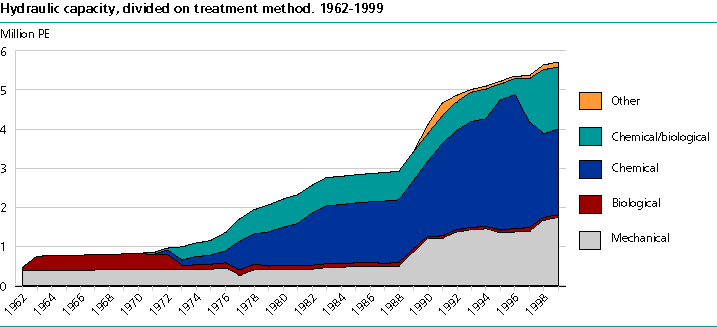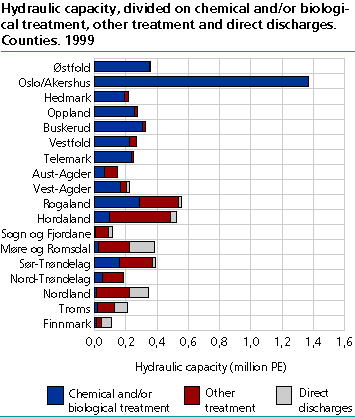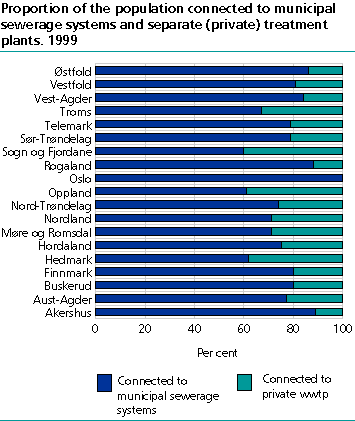Content
Published:
This is an archived release.
Nearly 2.900 waste water treatment plants
Preliminary figures show that almost 2.900 private and municipal waste water treatment plants of more than 50 PE were in operation in Norway in 1999, compared with 2800 in 1998. These treatment plants had a total capacity of 5.71 million PE. I addition, about 550 sewerage systems with discharges of untreated sewage were in operation.
Like our neighbouring countries, Norway has agreed to halve inputs of phosphorus and nitrogen to the North Sea, compared with the 1985 level. In order to meet our obligations, and at the same time improve the water quality of rivers, lakes and fjords, Norway has invested substantial resources in waste water treatment the last 20 years.
More chemical/biological treatment
For the country as a whole, chemical treatment is the most common treatment method (35 per cent of total hydraulic capacity). Mechanical treatment (28 per cent) and chemical/biological treatment (25 per cent) is also common, while treatment plants with biological treatment only constitute 1 per cent of total hydraulic capacity in Norway. At the end of the 1990's, the annual increase in hydraulic capacity have been marginal, which may indicate that satisfactory treatment of waste water has been achieved in many parts of the country. The most obvious change the last five years is the upgrade from chemical to chemical/biological treatment at a few large treatment plants in Eastern Norway. This has led to a reduction in chemical treatment from 58 per cent of total hydraulic capacity in 1996 to 35 per cent in 1999. For chemical/biological treatment there has been an increase from 7 per cent to 25 per cent in the same period.
Efficient treatment around the North Sea
In eastern and southern parts of Norway (the North Sea counties) most treatment plants have chemical or chemical/biological treatment (91 per cent of the total hydraulic capacity). This means that the waste water is treated either chemically or by a combination of chemical and biological treatment. In counties from Rogaland and northwards, regional and local authorities are allowed to make less strict demands when it comes to removal of pollutants. This is due to better conditions in resipients. In these areas, municipalities often choose to build simpler and more inexpensive treatment plants, like sludge separators, screens, strainers, sand traps and sedimentation plants. As a consequence, plants with chemical and/or biological treatment constitute only 24 per cent of total hydraulic capacity in these counties.
80 per cent connected to municipal sewerage systems
Altogether, 80 per cent of the population in Norway are connected to municipal waste water treatment plants. The proportion connected to municipal sewerage systems varies between counties, according to patterns of settlings and the authorities' treatment requirements. In the county of Sogn og Fjordane, only 60 per cent of the inhabitants are connected to municipal sewerage systems. The corresponding figure for Oslo is almost 100 per cent.
20 per cent connected to private plants
Annual reports from the municipalities indicate that about 895 000 people, or 20 per cent of the population in Norway, are connected to separate (private) treatment plants. Altogether, about 351 750 treatment plants of this kind are registered. Sludge separators (44.2 per cent) and sludge separators with infiltration (32.5 per cent) are the most common treatment methods.
| Separate (private) waste water treatment plants. Number of plants and people connected. 1999 |
|
Number of
people connected |
Number of
treatment plants |
Proportion of
all treatment plants |
|||||||||||||||||||||||||||||||||||||
|---|---|---|---|---|---|---|---|---|---|---|---|---|---|---|---|---|---|---|---|---|---|---|---|---|---|---|---|---|---|---|---|---|---|---|---|---|---|---|---|
| Total | 895 270 | 351 750 | 100,0 | ||||||||||||||||||||||||||||||||||||
| Sealed tank | 13 650 | 5 400 | 1,5 | ||||||||||||||||||||||||||||||||||||
| Separate toilet system | 37 600 | 14 610 | 4,2 | ||||||||||||||||||||||||||||||||||||
| Mini wwtp, chemical or chemical/biological | 8 550 | 3 350 | 1,0 | ||||||||||||||||||||||||||||||||||||
| Mini wwtp, biological | 2 900 | 1 130 | 0,3 | ||||||||||||||||||||||||||||||||||||
| Sludge separator with infiltration | 291 320 | 114 220 | 32,5 | ||||||||||||||||||||||||||||||||||||
| Sludge separator with sandfilter | 87 970 | 34 600 | 9,8 | ||||||||||||||||||||||||||||||||||||
| Sludge separator | 393 460 | 155 640 | 44,2 | ||||||||||||||||||||||||||||||||||||
| Direct discharges | 59 830 | 22 790 | 6,5 | ||||||||||||||||||||||||||||||||||||
| Source: Source: Waste water treatment statistics, Statistics Norway. |
Tables:
- Table 1 Number of sewerage systems (treatment plants and direct discharges), divided on treatment method and county. 1999
- Table 2 Hydraulic capacity, divided on treatment method and county. 1000 PE. 1999
- Table 3 Number of separate (private) treatment plants. 1999
- Table 4 Number of people connected to municipal sewerage systems and separate (private) treatment plants, and proportion connected to municipal sewerage systems. 1999



